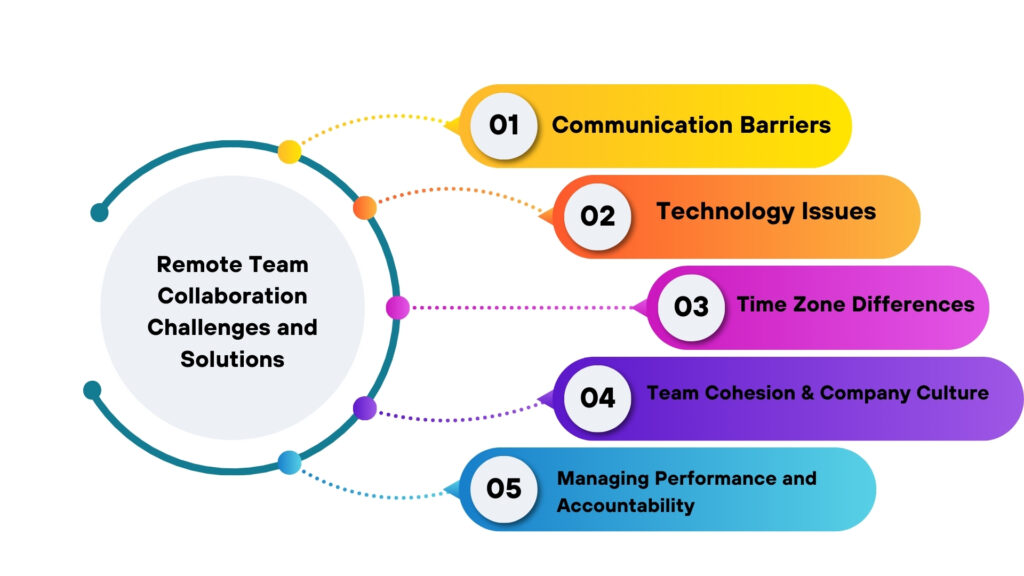
Remote Team Collaboration Challenges and Solutions
Remote work offers flexibility and convenience, but it also presents unique challenges that can affect team collaboration. While technology enables remote teams to stay connected, significant hurdles remain that can hinder productivity, communication, and cohesion. Below are some common challenges remote teams face, along with strategies for overcoming them.
- Communication Barriers
Digital tools make it hard for remote teams to communicate effectively while preserving the clarity and message meaning that fosters strong team performance. When working remotely we struggle to pick up subtle signals that help us correctly interpret each other’s intentions. Members of remote teams tend to encounter response delays due to time zone differences among team members.
How to Overcome It:
- Establish clear communication guidelines: Decide which digital platform to use based on message importance whether it needs formal email, quick Slack messaging, or scheduled video meetings. This approach stops messages from being unread or taking excessive time to deliver.
Use video conferencing regularly: Video calls help teams connect emotionally while making their messages easier to understand. These platforms serve best when teams discuss vital topics and conduct brainstorming activities to achieve mutual understanding.
- Encourage clarity in messages: Be explicit and clear in written communication. Ask your team members to clarify a task or message if they don’t understand it then confirm that they got it
2. Technology Issues
Remote teams are dependent on technology for communication, project management, and task execution. Technical problems, such as slow internet or software glitches, can disrupt workflows. Moreover, cybersecurity risks can arise when sensitive data is shared over digital platforms.
How to Overcome It:
Invest in reliable tools: Choose user-friendly and reliable communication and project management tools, such as Zoom, Slack, Asana, or Trello. Ensure everyone is trained in using them.
Provide necessary equipment: Ensure that team members have access to the necessary technology, including laptops, internet access, and cybersecurity resources.
Offer IT support: Provide quick access to technical support to resolve any issues efficiently.
3. Time Zone Differences
For global teams, time zone differences can be a significant obstacle to real-time collaboration. It’s challenging to schedule meetings or collaborate when team members are working at different hours of the day, leading to delays in decision-making and task completion.
How to Overcome It:
Establish overlapping working hours: Find a time window where team members from different time zones can be available to meet or collaborate, even if it’s only for a couple of hours.
Establish overlapping working hours: Find a time window where team members from different time zones can be available to meet or collaborate, even if it’s only for a couple of hours.
Plan meetings in advance: Schedule meetings well ahead of time, rotating meeting hours so no team member is always inconvenienced.
4. Team Cohesion and Company Culture
Remote work can lead to a sense of isolation, especially for team members who are physically distant from their colleagues. This lack of face-to-face interaction can hinder the development of team bonds and weaken company culture. Employees may feel disconnected from the organization’s mission, which can lead to lower engagement and morale.
How to Overcome It:
Promote social interaction: Encourage informal virtual gatherings, like virtual coffee breaks or happy hours, where team members can socialize outside of work-related discussions.
- Build inclusivity into the culture: Foster a sense of belonging by recognizing achievements, celebrating milestones, and maintaining regular check-ins.
- Organize virtual team-building activities: Regular team-building exercises, such as virtual games or collaborative challenges, can help maintain relationships and reinforce company culture.
5. Managing Performance and Accountability
Without the ability to oversee employees directly, remote managers may struggle with performance management and ensuring accountability. The lack of direct supervision can lead to unclear expectations, missed deadlines, or diminished productivity.
How to Overcome It:
- Set clear goals and expectations: Define measurable outcomes and deliverables for each team member, and track progress regularly. This will help ensure that everyone knows their responsibilities and can be held accountable for their work.
- Set clear goals and expectations: Define measurable outcomes and deliverables for each team member, and track progress regularly. This will help ensure that everyone knows their responsibilities and can be held accountable for their work.
Focus on results: Shift from tracking hours worked to evaluating the quality and timeliness of work. A results-oriented approach encourages autonomy and trust among team members.
6. Isolation and Mental Health
Remote workers can often feel isolated, which can affect their mental health and productivity. Without the social connections that come with working in an office, employees might experience loneliness or burnout, which can lead to disengagement.
How to Overcome It:
- Encourage regular check-ins: Schedule one-on-one meetings between managers and employees to discuss both work and well-being. This ensures that employees feel supported and have an outlet for any concerns.
- Provide mental health resources: Offer access to mental health services, wellness programs, or company-sponsored breaks to help prevent burnout.
- Foster work-life balance: Encourage employees to disconnect after work hours and take time off when needed to recharge. Maintaining a healthy balance between work and personal life is key to sustaining long-term productivity.
Conclusion
Remote team collaboration is undoubtedly full of challenges, from communication barriers to time zone differences and the risk of isolation. However, with the right strategies in place, these obstacles can be overcome. Clear communication, the use of reliable technology, fostering team cohesion, and setting clear expectations for performance are all essential for creating a productive and harmonious remote work environment. Recruitment agencies like TheDeskPro can play a key role in helping businesses build strong remote teams by finding the right talent. By addressing these challenges head-on, remote teams can thrive and collaborate effectively, regardless of their physical location.
